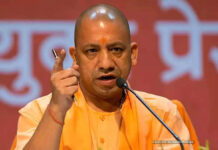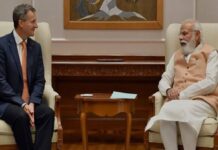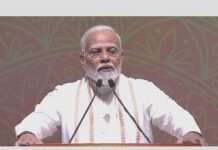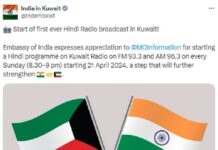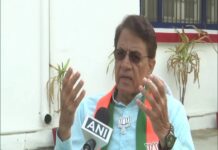AROONIM BHUYAN
NEW DELHI: Among the foreign leaders that Prime Minister Narendra Modi invited for his swearing-in ceremony May 30 for the second term in office was Mauritius Prime Minister Pravind Jugnauth. Mauritius? People may ask. But they have to look at the bigger picture. In inviting Jugnauth, Modi has sent a strong signal to the Indian diaspora across the world: the new government will continue with Modi 1.0’s policy of engaging with Indians abroad to make them stakeholders in the country’s movement forward.
After the swearing-in ceremony, Modi and Jugnauth held a bilateral meeting the next day in which both leaders agreed to further the ties between the two countries.
“Prime Minister Modi thanked Prime Minister Jugnauth and reiterated his commitment to further strengthening the fraternal and enduring bilateral ties between the two countries in all spheres,” the External Affairs Ministry said in a statement following the meeting. “Both leaders agreed to work together to achieve the shared vision of security and growth of the two countries and the Indian Ocean region.”
This was Jugnauth’s second visit to India this visit this year after he came here in January as the chief guest of the Pravasi Bharatiya Divas (PBD), the Indian diaspora conclave organized by the External Affairs Ministry.
Mauritius is a multi-ethnic society, the majority comprising people of Indian origin. Around 68 per cent of Mauritius’ population of around 1.3 million are of Indian descent.
In 1598, the Dutch took possession of Mauritius. an island nation of the east coast of Africa. They abandoned Mauritius in 1710 and the French took control of the island in 1715, renaming it Isle de France. France officially ceded Mauritius, including all its dependencies, to Britain through the Treaty of Paris, signed May 30, 1814 and in which Réunion was returned to France. So, one might consider it more than a coincidence that Jugnauth was here to attend Modi’s swearing-in ceremony May 30 this year.
The British colony of Mauritius consisted of the main island of Mauritius along with Rodrigues, Agalega, St Brandon, Tromelin and the Chagos Archipelago, while the Seychelles became a separate colony in 1906.
From the 1820s, Indian workers started coming to Mauritius to work on sugar plantations. From 1834, when slavery was abolished by the British Parliament, large numbers of Indian workers began to be brought to Mauritius as indentured labourers. November 2, 1834, marks the day when the ship Atlas docked in Mauritius carrying the first batch of Indian indentured labourers. This day is now observed in Mauritius as ‘Aapravasi Day’. In all, about half a million Indian indentured labourers are estimated to have been brought into Mauritius between 1834 and the early decades of the 20th century, out of whom about two-thirds settled permanently in that country.
A brief stopover by Mahatma Gandhi en route to India from South Africa (October 29 to November 15, 1901), while awaiting departure of his ship SS Nowshera, is still etched in the consciousness of Mauritius. Barrister Manillal Doctor, who came to Mauritius in 1907 on the suggestion of Gandhi, helped the Mauritian Indian community to organize themselves and laid the foundation for their struggle for political and social rights. As a tribute to Gandhi and the Indian freedom struggle, the National Day of Mauritius is celebrated March 12 – the date of the launch of Gandhi’s Dandi March, an eponymous event in India’s freedom struggle.
Following Mauritius’ independence March 12, 1968, the first Prime Minister and the Father of the Mauritian nation Sir Seewoosagur Ramgoolam, a person of Indian origin, accorded centrality to India in Mauritius’ foreign policy. Subsequently, successive Mauritian leaders ensured that India occupies a position of significance and importance in the foreign policy orientation and activities of Mauritius.
When Jugnauth visited India in January for the PBD, he and Modi reviewed the entire gamut of the strategic relationship between both countries, based on deep emotional bonds of kinship and culture.
The External Affairs Ministry said in a statement the talks focussed on initiatives to further strengthen the bilateral ties, including finalization of the Comprehensive Economic Cooperation Partnership Agreement (CEPCA).
India is Mauritius’ largest trading partner and has been the largest exporter of goods and services to the Indian Ocean island nation since 2007.
“The various ongoing bilateral development cooperation projects were discussed and new proposals for critical partnership projects in health, disaster management and energy were agreed upon,” the ministry statement.
“The leaders also discussed ways to expand further cooperation in areas of Blue Economy and collaboration in Africa.”
In March 2015, less than a year after he took charge as Prime Minister, Modi visited Mauritius as part of a three-nation tour that he undertook in the Indian Ocean region that also included the Seychelles and Sri Lanka. During the course of that visit, Modi further cemented India’s its ties with Mauritius with the commissioning of an India-built coast guard patrol vessel, inked five agreements and announced a $500-million line of credit, while stressing on the strategic importance of the Indian Ocean region and pressing for a strong grouping of the region’s nations.
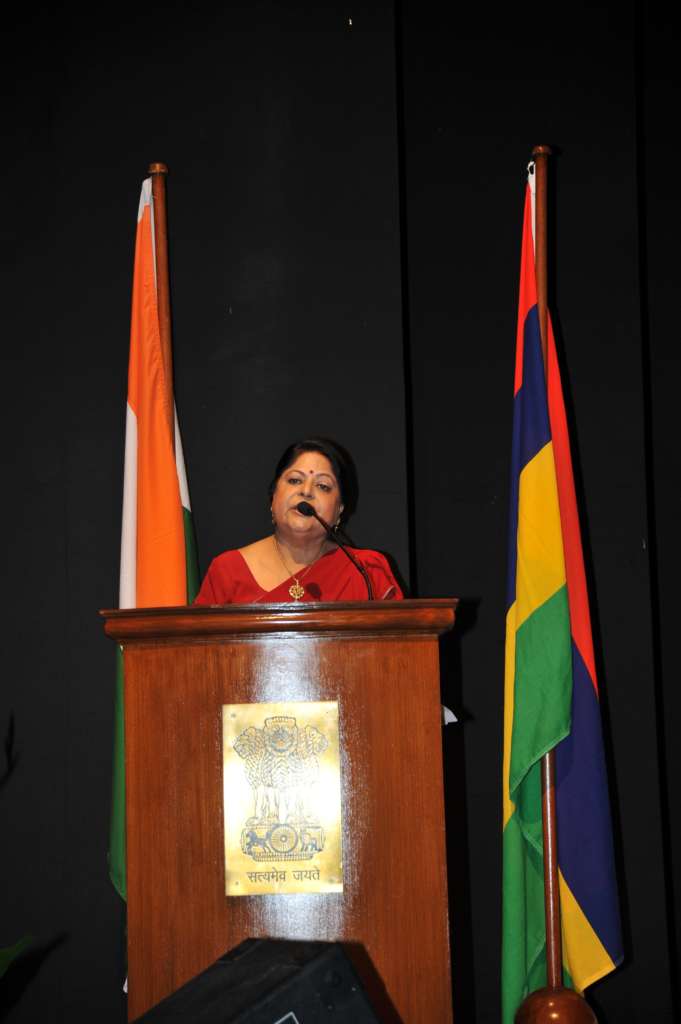
Observers see it as India’s attempt to countermand China’s growing influence in the region.
During the course of that 2015 visit, Modi strongly emphasized upon the close people-to-people links between the two countries, by his visit to the Ganga Talao temple, where he offered oblations at the Shiva temple, his visit to the Aapravasi Ghat where the Indian indentured labourers had arrived 100 years ago, and his talk at a civic reception at the Mahatma Gandhi Institute.
He praised the contributions of the Indian-origin people and in a speech at the country’s National Assembly, he said the destinies of both nations were “linked by the currents of the Indian Ocean”.
According to a paper published by Professor V.N Attri, of the University of Mauritius in 2016, the new emerging development paradigm of the Blue Economy, which is inclusive of the Ocean Economy, Green Economy, Coastal Economy and Marine Economy, has a great potential for higher and faster GDP growth scale in the Indian Ocean Region (IOR).
“Blue Growth focusing on the long-term sustainability ofoceans has become a realistic policy frame within IORA (Indian Ocean Rim Association) during the last two years, beginning from October,2014,” Attri wrote. “The Blue Economy advocates the same outcome as the Green Economy, namely improved human well-being and social equity, while significantly reducing environmental risks and ecological scarcities.”
The IORA is an apex regional organization of 22 member states, including India and Mauritius, and nine Dialogue Partners stretching from South Africa in the west, running up the eastern coast of Africa, along the Gulf to South and Southeast Asia, ending with Australia in the east.
Apart from economic ties, New Delhi has maintained strong cultural ties with Mauritius over the years. The Indira Gandhi Centre for Indian Culture (IGCIC) at Phoenix is one of the largest centres of the Indian Council for Cultural Relations (ICCR), which from March 2000, has emerged as an important venue for promotion of Indian cultural activities in Mauritius. The IGCIC holds classes in disciplines ofHindustanimusic, Kathak, tabla and yoga for Mauritian students. A Cultural Exchange Programme (CEP) (2015-2018) was signed in March 2015. A Festival of India in Mauritius 2015 was organized in collaboration with the local ministry of arts and culture.
The Mahatma Gandhi Institute (MGI) was established in 1970 as a joint venture between the governments of India and Mauritius for the promotion of Indian culture and education. It also hosts the ICCR Chair in Sanskrit and Indian Philosophy. The Rabindranath Tagore Institute was established with the assistance of the Indian government in2000 as a Centre of Studies on Indian culture and traditions. Mauritius also hosts the World Hindi Secretariat. Yoga and traditional Indian systems of health are extremely popular among the general public in Mauritius. An active network of local socio-cultural organizations and language unions add further strength and vitality to the vibrant people-to-people contacts.
The Indian Technical and Economic Cooperation (ITEC) has been India’s flagship capacity building program since its inception in 1964 and has acquired a strong brand name in India’s development partnership with Mauritius. Mauritius is one of the largest beneficiary countries of the ITEC program.
Mauritian nationals have taken advantage of large number of scholarships offered by India on civilian and defence-related training courses at Indian institutions.
The Pan African e-Network Project was inaugurated February 26, 2009, in Mauritius which connected it and other African countries with India through a satellite and fiber-optic network. It has benefited Mauritius with sharing of India’s expertise in education and health care.
Around 100 ICCR scholarships are extended annually to Mauritian students for higher education in India. Around 200 other Mauritian students enrol themselves in Indian universities every year on a self-financing basis. India ranks fourth in terms of Mauritian students studying in overseas tertiary education institutions.
In the light of all these, Modi’s invitation to Jugnauth May 30 was more than just symbolic. It has sent out the signal that New Delhi will continue engaging with its diaspora across the world during Modi 2.0.


